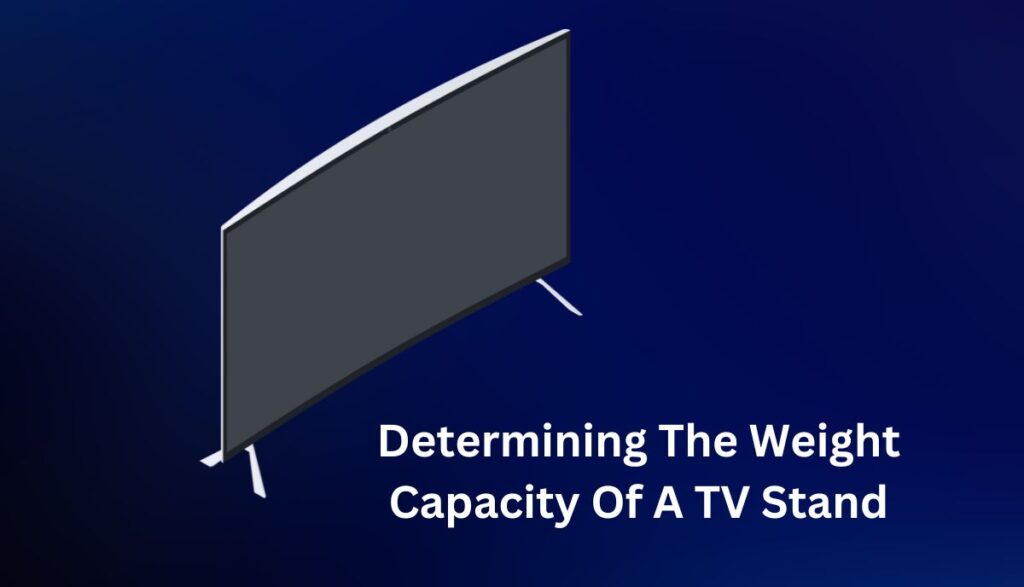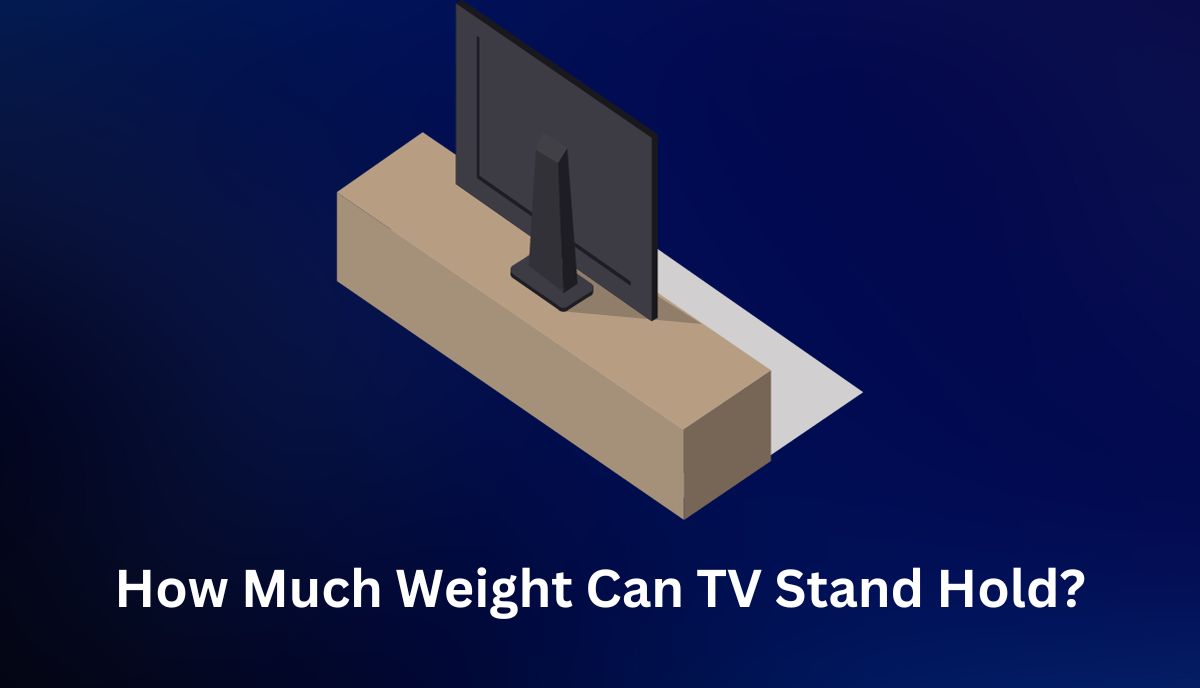A flimsy TV Stand will collapse under the weight of a heavy TV. You can avoid this outcome by pairing TVs with Stands strong enough to handle their weight. But that is only possible if you know the weight capacity of the TV Stand. That raises a question. How much weight can a TV Stand hold? How
| TV Stand That Can Hold 100 Pounds | 23 – 75 Inches Tripod TV Stand |
| TV Stand That Can Hold 150 Pounds | 32 – 65 Inches Rolling TV Cart |
| TV Stand That Can Hold 200 Pounds | ONKRON 50 – 86 Inches Mobile Stand |
| TV Stand That Can Hold 300 Pounds | YITAHOME 65 Inches Entertainment Center |
| TV Stand That Can Hold 75 Pounds | 32 – 80 Inches 99 lbs Universal TV Stand |
| TV Stand That Can Hold 85 Pounds | 32 – 75 Inches 100 lbs Mobile TV Cart |
You should treat each TV Stand as an individual entity with unique limitations. Admittedly, you have more room to breathe than the weight capacity suggests. A TV Stand with a weight capacity of 100 pounds can carry more than 100 pounds.
Manufacturers tend to set the weight limit below the TV Stand’s breaking point. This provides some leeway for errors and encourages some consumers to exceed their TV Stand’s weight limit, which is fine as long as you stay within a few pounds of the manufacturer’s recommended weight.
Ultimately, staying within the manufacturer’s recommended limits is safer. Otherwise, if the Stand breaks and your TV shatters because you exceeded the Stand’s weight limit, the manufacturer won’t compensate you.
How Can I Determine The Weight Capacity Of My Specific TV Stand?

Determining the weight capacity of an older TV Stand is not easy. After all, these items rarely feature labels. Unlike electronic appliances such as microwaves, which have nameplates revealing their wattage and voltage ratings, TV Stands are typically bare, especially the wooden models.
This paper from bioresources.com (Milos Hitka, Silvia Blaskova, Pavol Joscak, Lubos Kristak, and Nadezda Langova) shows readers how to determine the load-carrying capacity of a chair in populations where the average body weight has increased.
Technically, you can apply those formulas to TV Stands, many of which mimic conventional furniture.
This Woodworking Stack Exchange Thread includes a formula for calculating the maximum bending stress (sigma = M*y/I). But as a layperson, do you know what those symbols mean, let alone how to apply them? Probably not.
You could experiment with Engineers Edge. The platform has calculators that determine the beam deflection and stress of cross-section geometry. But that means measuring the TV Stand to identify its dimensions before inserting them into the calculators.
The Engineering Toolbox provides similar guidance. But again, laypeople don’t understand these concepts enough to measure and calculate the weight capacity of a TV Stand. This is not a problem for new TV Stands because you can simply refer to the manual.
It will tell you the weight limit of the Stand as a whole and the load capacity of the individual cabinets and shelves. Consider Robert from this Best Buy forum, who published a section of a TV Stand manual that reveals the capacity of the Stand and its shelves.
Robert found this manual online. You can do the same. Reach out to the manufacturer and ask for their Stand’s weight limit or the manual. If you don’t know where the Stand comes from, take a picture and post it in an online forum of experts in the field. They will guide you accordingly.
Review sites are helpful in this arena because their community members are well-versed in TV Stands. One of them will identify your Stand and reveal its weight capacity.
You can apply this option to an older Stand without a manual. If you can’t access the internet, you’re out of luck. According to this Maka Furniture blog post, they test the load-bearing capacities of their chairs by placing a load on each chair, removing it after 24 hours, and assessing the integrity of the structure.
You can attempt a similar experiment. Place a TV on the Stand and see what happens. Does it immediately buckle? Do you hear creaking? If nothing happens, wait a few more hours before removing the TV and assessing the damage.
If the Stand is clearly sagging, cracking, or damaged in any way, you can conclude that your TV is too heavy for it. Admittedly, you can’t trust this approach. A Stand may tolerate a TV’s weight today only to fail and break a few days later.
Therefore, you should consult an expert. Let them physically assess the Stand to determine whether or not it can withstand your TV’s weight. In the case of wooden Stands, talk to a carpenter. They will advise you accordingly.
Are There Different Weight Limits For Different Types Of TV Stands, Such As Wall-Mounted Stands Or Floor Stands?
Technically, you can find the weight capacities you want in every type of TV Stand. However, some Stand types cannot hold the largest and heaviest TVs. This is why debates about wall-mounted and floor stands are so rife.
Many consumers love wall-mounted Stands because of their convenience. First of all, they save space. Secondly, they are sleek and attractive. They tend to accentuate your home’s decor.
However, they are inferior to floor Stands, at least where the weight capacity is concerned. The following factors prove as much:
- Base
Floor Stands have a base that guarantees stable support for the largest and heaviest TVs. Compare that to a wall-mounted Stand, which must carry the TV’s entire weight. Even if the material is strong enough to withstand the stress, the TV’s weight can pull the screws out of the wall.
With Floor Stands, you can buy models with the broadest possible base that a technician can fix to the floor, enhancing its stability.
- Material
Because floor Stands can hold more weight, manufacturers use heavy-duty steel to make them. With wall-mounted Stands, the manufacturer can’t afford to make the Stand too heavy. Otherwise, the combined weight of the Stand and the TV may rip the screws from the wall.
- Convenient
Wall Stands are less convenient. First, they compel the user to drill holes in the wall. Secondly, moving a wall Stand to a new location is time-consuming. It means drilling new holes and then patching the old ones.
What Factors Should I Consider When Calculating The Weight Capacity Needed For My TV And Additional Equipment?
If you’re afraid of getting the weight capacity wrong, try to keep the following in mind before buying a Stand for your TV:
1). Height
Is the Stand’s height fixed or adjustable? This matters because heavy loads are less stable at greater heights. Stick to shorter Stands for the largest and heaviest TVs. You should only experiment with tall Stands when the TV is lightweight.
2). Swiveling Functions
Does the Stand include additional features and functions? For instance, can it change the TV’s angle by swiveling or tilting? Stands with such features tend to accommodate lightweight TVs. You can find swiveling Stands with significant weight limits, but they have hefty price tags because of the robust materials manufacturers use to construct them.
3). Material
Stands with a glass base are risky, even if the glass is tempered. A strong blow may compromise the material’s integrity. Metallic bases are more appealing. You can trust them to stand the test of time.
4). Additional Storage
Is the Stand primarily designed to hold the TV, or does it include shelves and cabinets for your accessories? You should account for the weight of those accessories when determining a Stand’s compatibility with your TV.
Even when the TV is lightweight, you can accidentally exceed the Stand’s weight limit by packing the shelves and cabinets with Bluray Players, set-top boxes, gaming consoles, vases, etc. Many manuals mention the weight limitations of each shelf.
Are There Safety Guidelines Or Standards For Ensuring A TV Stand Can Safely Hold A TV Of A Specific Weight?

- Stay within the weight limit stated in the Stand’s manual. While some manufacturers set the weight capacity below the Stand’s actual limit, don’t take any chances. Listen to the manual. The stand’s weight capacity should exceed the TV’s weight.
- Stick to Stands with a broad base. A Stand with a narrow base is at risk of tipping over.
- Where possible, look for Stands whose width exceeds the TV’s measurements. You want the TV to sit in the middle of the Stand with plenty of room to spare on either side.
- Use a shorter Stand if the TV exceeds the Stand’s width and weight capacity. Tall TV Stands will tip over.
- If you prefer glass Stands, prioritize tempered glass.

